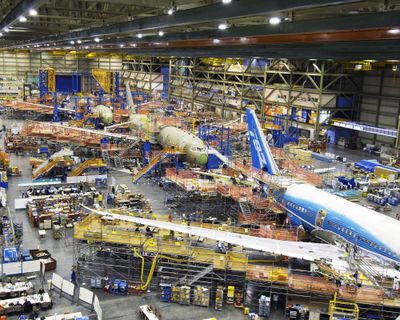Dreamliner still far from flight
Boeing’s design fix likely months away

SEATTLE – The structural flaw that delayed the first flight of the 787 Dreamliner is more complex than originally described by the company, and the plane’s inaugural takeoff is likely at least four to six months away, say two engineers with knowledge of Boeing’s problem.
“It’s got to take at least three to four months just to get something installed on an airplane,” said a structures engineer who has been briefed on the issue. “It’s definitely a costly fix to go and do this work.”
A second engineer, who is familiar with the details of Boeing’s construction method, said the fix must first be made on the nonflying test airplane in the Everett, Wash., factory. Assuming that’s successful, it will take another month or two to install the fix on the first airplane to fly.
Both engineers said the issue requires a thorough redesign of the plane’s wing-to-body join, and the necessary parts will be very difficult to install on the test airplanes that have already been built.
The engineers’ accounts differ from Boeing’s description June 23 when it acknowledged a problem and again postponed the first flight of the much-delayed plane.
Dreamliner program chief Scott Fancher said then that the fix would be “a simple modification” requiring only “a handful of parts.” But almost a month later, Boeing has neither set a new schedule nor outlined its planned fix of the problem.
The second engineer said the problem is caused by high loads at the ends of the stringers on the upper wing skins. Stringers are the long composite rods, shaped like I-beams, that stiffen the inside of the wing skin.
There are 17 stringers on each upper wing, all of them subject to compression forces when the wings flex upward in flight. At the point where each stringer ends, close to where the wing and body of the plane are joined, those forces pull the stringer away from the skin.
During a wing-bending test in May on the ground-test airplane inside the Everett factory, the fibrous layers of the composite plastic material delaminated at these stress points.
Such a separation of the material isn’t likely to lead to catastrophic failure of the airplane, but it would require constant monitoring and potentially costly repairs by the airlines. Any tear in the material would have to be promptly fixed to avoid spreading of the delamination.
If Boeing’s initial fix fails to divert enough of the load away from the stress points, the delay in first flight could extend beyond six months, pushing the date out into 2010.
“There’s no guarantee that what (Boeing) is doing will work,” the second engineer said. “If the testing or analysis shows it doesn’t get rid of the load, then the engineers are back to square one.”
Beyond first flight, solving the structural flaw could also further slow the plan for ramping up production.
Boeing’s current focus is on an interim solution to the stringer problem for the test planes that it has already built. The first engineer said Boeing hasn’t had time yet to figure out at what point in production to introduce a permanent redesign on all subsequent jets.
“None of that is nailed down yet,” he said. “There’s no schedule.”